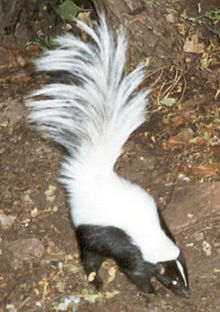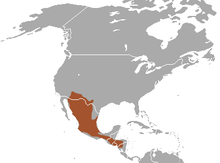Species of carnivore
| Hooded skunk |
 |
Conservation status |
 Least Concern (IUCN 3.1)[1] |
Scientific classification  |
| Domain: | Eukaryota |
| Kingdom: | Animalia |
| Phylum: | Chordata |
| Class: | Mammalia |
| Order: | Carnivora |
| Family: | Mephitidae |
| Genus: | Mephitis |
| Species: | M. macroura |
| Binomial name |
Mephitis macroura
Lichtenstein, 1832 |
 |
| Hooded skunk range |
The hooded skunk (Mephitis macroura) is a species of mammal in the family Mephitidae. Mephītis in Latin means "foul odor", μακρός (makrós) in Greek translates to "long" and οὐρά (ourá) translates to "tail".
Morphology
It can be distinguished from the similar striped skunk (M. mephitis) by its longer tail and longer, much softer coat of fur, and larger tympanic bullae.[2] A ruff of white fur around its neck gives the animal its common name. Three color phases are known and in all three, a thin white medial stripe is present between the eyes: black-backed with two lateral white stripes, white-backed with one dorsal white stripe, or entirely black with a few white hairs in the tail.[3][4]
Ecology
The hooded skunk ranges from the Southwestern United States to Mexico, Guatemala, Honduras, Nicaragua, and northwest Costa Rica.[1] It is more abundant in Mexico. These skunks are found to be more than 50% smaller in size in southern Mexico than in the Southwestern United States.[5] It is found in grasslands, deserts, and in the foothills of mountains, avoiding high elevations. It tends to live near a water source, such as a river. The females tend to be 15% smaller in size than the males[6] and their breeding season is between February and March.[4] The litter size ranges from three to eight.[7]
Diet
The diet of the hooded skunk consists mostly of vegetation, especially prickly pear (Opuntia spp.), but it will readily consume insects, small vertebrates, fruit, bird eggs, and human garbage as well.[4][8] Hooded skunks in Costa Rica utilize their forelimbs to throw bird eggs between their hindlegs, in order to break the eggs open.[8] In the wild, their stomach contents include 74.3% insects, with 50% of their diet consisting of earwigs, stink bugs, and beetles. Vertebrate tissues made up 12% of the diet, and only about 1% of the diet consisted of plant material.[8] No cases of rabies are reported,[9][10] but they host a range of parasites, including nematodes, roundworms, and fleas.[4]
Behavior
Hooded skunks are solitary, but they might interact at a feeding ground without showing any signs of aggression.[11] They shelter in a burrow or a nest of thick plant cover during the day and are active at night. Like M. mephitis, for self-defense, they spray volatile components from their anal glands.[12] Seven major components comprised 99% of the volatiles in this secretion: (‘’E’’)-2-butene-1-thiol, 3-methyl-1-butanethiol, ‘’S’’-(‘’E’’)-2-butenyl thioacetate, ‘’S’’-3-methylbutenyl thioacetate, s2-phenylethanethiol, 2-methylquinoline, and 2-quinolinemethanethiol[13]
Characteristics
Hooded skunks are currently not endangered. They are very abundant in Mexico and can live in human suburban areas mostly on pastures and cultivated fields.[14] Their fur has low economic value.[7] However, their fat[12] and scent glands[11] can be used in local folk medicine. In some parts of their range, their flesh is considered a delicacy.[15] Other common names for the hooded skunk include: mofeta rayada (Spanish), moufette à capuchon (French), pay (Maya), southern skunk, white-sided skunk, and zorillo.[16]
References
- ^ a b Cuarón, A.D.; González-Maya, J.F.; Helgen, K.; Reid, F.; Schipper, J.; Dragoo, J.W. (2016). "Mephitis macroura". IUCN Red List of Threatened Species. 2016: e.T41634A45211135. doi:10.2305/IUCN.UK.2016-1.RLTS.T41634A45211135.en. Retrieved 12 November 2021.
- ^ Hall, E. R. (1981). The mammals of North America (Second ed.). New York: John Wiley & Sons. pp. 601–1181.
- ^ Hoffmeister, D. F. (1986). Mammals of Arizona. Tucson: University of Arizona Press.
- ^ a b c d Patton, R. F. (1974). Ecological and behavioral relationships of the skunks of Trans Pecos Texas. Ph.D. dissertation. Texas A&M University. p. 199.
- ^ Janzen, D. H. and W. Hallwachs (1982). The hooded skunk, Mephitis macroura, in lowland northwestern Costa Rica. Brenesia. pp. 19/20:549–552.
- ^ Rosatte, R. C. (1987). Striped, spotted, hooded, and hog-nosed skunk. Toronto, Canada: Ontario Ministry of Natural Resources.
- ^ a b Bailey, V. (1932). "Mammals of New Mexico". North American Fauna. 53: 1–412. doi:10.3996/nafa.53.0001.
- ^ a b c Bairos, Kevin (2013-10-26). "ADW: Mephitis macroura: INFORMATION". Animaldiversity.org. Retrieved 2022-03-19.
- ^ Aranda, M.; L. Lopez-De Buen (1999). "Rabies in skunks from Mexico". Journal of Wildlife Diseases. 35 (3): 574–577. doi:10.7589/0090-3558-35.3.574. PMID 10479094. S2CID 6611338.
- ^ Ceballos, G., And A. Miranda (1986). Los mamiferos de Chmela, Jalisco: manual de campo. Mexico City, Mexico: Universidad Nacional Autonoma de Mexico.
{{cite book}}: CS1 maint: multiple names: authors list (link) - ^ a b Reid, F. A. (1997). A field guide to the mammals of Central America and south east Mexico. New York: Oxford University Press.
- ^ a b Dalquest, W. W. (1953). Mammals of the Mexican state of San Luis Potosi. Balton Rouge: Louisiana State University Press.
- ^ Wood W. F.; Sollers B. G.; Dragoo G. A.; Dragoo J. W. (2002). "Volatile Components in Defensive Spray of the Hooded Skunk, Mephitis macroura". Journal of Chemical Ecology. 28 (9): 865–870. doi:10.1023/A:1020573404341. PMID 12449512. S2CID 19217201.
- ^ Yeen, Ten Hwang; Serge Lariviere (26 December 2001). "Mephitis macroura". Mammalian Species. 686: 1–3. doi:10.1644/1545-1410(2001)686<0001:mm>2.0.co;2. S2CID 198969295.
- ^ Davis, W. B. (1944). "Notes on Mexican mammals". Journal of Mammalogy. 25 (4): 370–402. doi:10.2307/1374900. JSTOR 1374900.
- ^ Borror, D. J. (1960). Dictionary of word roots and combining forms. Palo Alto, California: National Press Books.
- Irwin, M. 2001. Mephitis macroura (on-line), Animal Diversity Web. Accessed September 13, 2006
External links
- Smithsonian Institution - North American Mammals: Mephitis macroura
Taxon identifiers |
|---|
| Mephitis macroura | |
|---|
Authority control databases: National  | |
|---|












